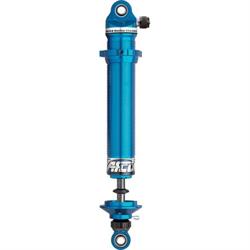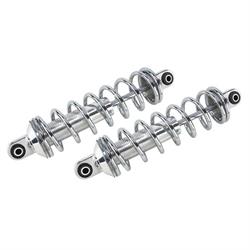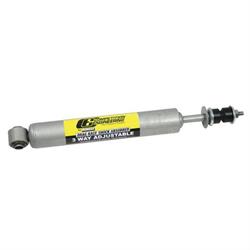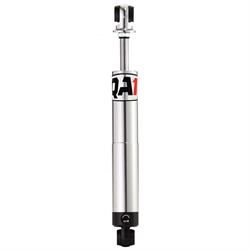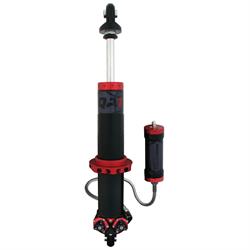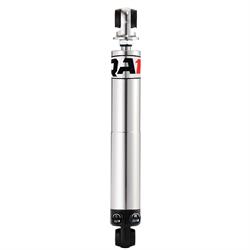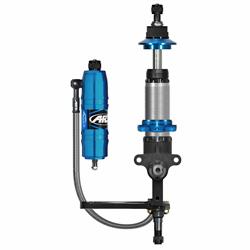Drag Shocks & Struts Guide | Suspension Tuning and Setup
Drag Race Shocks 101
When mapping out your plan for that killer drag car, it’s easy to focus on ways to build more horsepower, beefy transmissions and rear axles to handle it, and the best drag tires to put it to the ground. It’s also important to remember the critical role that drag race shocks play in the overall setup of a fast and safe drag car.
Finding the best shock absorbers for your car is an exercise in finding the best drag shocks your chassis type, power level, and budget. Your street driven small-tire car with a 500-horse small block likely will not require a $3,000 pair of 4-way adjustable rear shocks. Likewise, a 6-second tube chassis car will need a shock with specialized valving and plenty of tuning options. Consider this article a "Racing shocks 101" course to help you make the right decision for your car.
What is the Difference Between Shocks and Struts?
The primary job of a shock absorber is to absorb the inputs from the road or track and dampen the energy of the spring that’s carrying the weight of the car. Struts do the job of the shock as well as serving as a structural component of the suspension and the upper steering pivot. In the common MacPherson strut design, the strut attaches directly to the spindle and essentially replaces the upper control arm.
Shocks vs. Coilovers
A coilover is a type of tube shock that also has a spring seat on it, combining the shock and spring into one unit. Do coilovers replace shocks? Essentially, the coilover is the shock, or rather an assembly that is comprised of both the shock as well as the spring. Coilovers typically have threaded bodies, which allow the spring seat to be threaded up and down on the body, thereby changing the car’s ride height. This design also facilitates fine adjustments to the car’s weight distribution.
Drag Racing Front Suspension Setup
We often think first of the rear suspension setup on a drag car. After all, this is where the power is being put down to the track. But it’s important to remember that the drag car front suspension setup plays a critical role as well. When considering the best front drag shocks for your car, it’s important to first consider the design of the suspension itself.
Most of us are familiar with independent front suspension designs using an upper and lower control arm. These are common to most cars from the late 40’s through the muscle era of the 60’s and 70’s. As such, you’ll find a wide selection of direct-fit drag racing shocks available for many of these cars.
In the 60’s, enterprising drag racers began to swap out those heavy front suspensions in favor of simple, lightweight straight axles. This design also commonly increased the front ride height, resulting in a favorable increase in rear weight bias. Straight axle “gasser” style cars are still popular and many are running impressive numbers in spite of their seemingly archaic suspension setups. These cars will use different shocks than a car equipped with an independent front suspension. We chose Afco shocks for our “gasser” Nova project. Since these setups are often custom made, pay close attention to mounted, compressed, and extended lengths when choosing shocks for a straight axle car.
Take a look at a modern Pro Stock car or many of the most competitive “drag and drive” cars out there and you will see drag racing front struts on the front suspension. Favored for simplicity and light weight, drag racing struts are widely used in modern drag cars. It’s also becoming common to see late model, strut-equipped cars such as Mustangs and Camaros being built into drag cars. These cars were equipped with struts from the factory and will use direct fit drag racing front struts.
Best Rear Shocks for Drag Racing
Rear drag racing shocks play a critical role in the car’s setup, and adjustable shocks add a great tool to your tuning arsenal. Here are some things to look at when comparing modern racing shock absorbers to help you answer the question of "what shocks do I need?"
Single Adjustable Shocks for Drag Racing
Adjustable shocks are incredibly useful on street/strip cars since they allow you to dial in the killer setup on the track, then make adjustments for a smoother ride on the street.
Single adjustable shocks will typically have a knob that allows the user to make adjustments to the shock’s valving.
Adjustment can be to the shock’s compression, rebound, or both.
Compared to a non-adjustable shock, drag racers will find this adjustability to be a valuable tuning tool.
Double Adjustable Shocks for Drag Racing
Double adjustable shocks feature separate adjustments for compression and rebound.
When it comes to single vs. double adjustable shocks or coilovers, the cost of double adjustable shocks tends to be higher, but they open the door to tuning changes that can make a big difference in the way the car hooks up and handles at speed.
Most drag race shock tuning guides will make reference to separate compression and extension adjustments that only double adjustable shocks will allow for.
Drag Race Coilover Shocks
In addition to any adjustment to the valving on the shock itself, coilovers add the ability to adjust ride heights and facilitate easier spring changes.
By threading the adjuster up and down on the shock, the spring is compressed or relaxed, raising or lowering the car. This also changes static weight distribution and can affect the car’s performance on the track.
Installing drag coilovers on a car will usually require some beefing up of the shock mounting points. Adding coilovers means that the shock is also suspending the car. Most factory shock mounts were not designed to handle that much force.
In addition to the adjustability inherent in coilovers, the design also lends itself well to a drag car where spring rate changes may be necessary at the track. Not only are stock coil springs limited when it comes to available rates, they’re also difficult to remove and replace. In the front, ball joints have to be broken loose and then great care must be taken to keep the spring contained until all the energy has been released to prevent it from becoming a destructive projectile. Coilovers, however, are easy to remove and the threaded adjuster allows for easy spring rate and length changes.
4-Way Adjustable Shocks for Drag Racing
4-way adjustable shocks are state of the art shocks that are run by the fastest cars on the track in drag racing and other venues all the way up to Formula 1.
4-way shocks separate high-speed compression and rebound from low-speed compression and rebound.
Think of the difference between low speed and high speed like this: the motion of the chassis pushing down on the tire is low speed, while the motion of the tire pushing up into the chassis is high speed.
As an example that oversimplifies the vast tuning options available, 4-way shocks allow for low speed adjustment to manage the way the chassis is transferring weight in the corners or at launch, then high speed tuning to manage the way the car goes over bumps. With 4-way shocks, the door is wide open to very precise drag racing suspension tuning changes that are usually only beneficial to the most experienced drivers and crews. For anyone other than the professionals, the significant expense of 4-way shocks might be better spent making other parts of the car better and safer.
Best Shock Absorber Brands
Speedway Motors offers a huge variety of performance shocks for many applications. Here’s a look at a few popular drag racing shock brands:
QA1 Drag Racing Shocks
QA1 produces a number of drag racing shocks to fit various applications in double, single, Drag "R" Series and non-adjustable valving options. We’ve used single adjustable coilovers from QA1 on street cars that occasionally hit the track and found that adjustability to be a hugely valuable tool. And their new Mod Series shocks offer even more flexibility as well as tuning for both high and low speed valving.
Afco Drag Coilovers
Afco has been making shocks for drag racing for a long time and they’ve developed a wide variety of shocks, struts, and coilovers for drag racing use in cars with various power levels and chassis types. Their Eliminator double adjustable drag shocks are available as shocks and coilovers for just about any application you can think of. And Afco’s testing using on-board diagnostics has led to the development of useful options like BNC bounce control valving for cars that are pulling the front tires and Big Gun shocks that are the best shock absorbers for cars that are making big power. For more, here's an Afco shock review of Eliminator drag shocks. .
Competition Engineering Adjustable Drag Shocks
Competition Engineering is an iconic brand that has been part of drag racing shock and chassis technology for a long time. Speedway Motors carries their line of 3-way adjustable racing shocks that are valved specifically for drag racing. Their front and rear adjustable drag shocks are tunable in three ratios and they adjust by compressing the shock fully and rotating the shaft until the indexing notch mates with the desired setting on the body. Competition Engineering 3-way adjustable shocks are available for a wide variety of chassis and suspension types.
Speedway Motors Coilovers for Drag Racing
Speedway Motors PRO coilovers are primarily used on street rods, but they offer some interesting features for drag racers on a budget. There are three valving adjustments on these shocks, from soft to medium to firm. While not as comprehensive as other adjustable shocks, these will provide some tunability that will come in handy when setting up a mild street/strip car. Not to mention the inherent advantages of the coilover design. These shocks are recommended for cars weighing less than 3200 pounds, so they will not be the best option for muscle cars and late models that haven’t been lightened significantly.
Drag Racing Shock Tuning Guide
What is Shock Ratio?
We’ve all heard of the famous “90/10 drag shock.” Those numbers represent the shock ratio, and to understand what that ratio means and what it will do to a drag car, let’s first talk about compression and rebound.
Compression refers to the amount of damping or stiffness a shock will have as it is being compressed, or pushed together. Rebound or extension refers to the opposite; the amount of damping a shock has when it’s being extended, or pulled apart. As discussed above, adjusting compression and rebound is a valuable tuning tool on a drag car. Shock ratio is the amount of force needed to compress and extend a shock, typically expressed as compression/rebound. So when you see that 90/10 shock referenced earlier, that means that it takes nine time more pressure to compress the shock than it does to extend it. The result when used on the front is a shock that’s designed to allow the front to unload quickly, rapidly transferring weight to the rear for traction, then slowly settle the frontend as the car makes its way down the track. It’s easy to understand how a car will react differently when equipped with 90/10 shocks than it would when equipped with a 50/50 shock where forces are equal on compression and rebound.
Now that we’ve established what that ratio means, here is a shock ratio chart showing some common drag race shock setups. These also happen to correlate with the Competition Engineering 3-way adjustable shocks settings:
How to Adjust Shocks
Drag cars are complicated machines and there are many variables to consider when tuning your drag race suspension setup at the track. But for some general recommendations on drag shock tuning, we hit up our friends at Afco for some tips and suggestions on how to adjust adjustable shocks that are commonly used in drag racing.
If the car is spinning the tires as soon as it launches, try softening the extension on the front to increase weight transfer. Also softening the extension on the rear will hit the tires harder and increase traction.
If the car hooks initially, then starts spinning, it’s possible that the rear shocks are too soft on both compression and extension. The suspension is hitting the tires harder than the shocks are set to control, leading to the tire “bouncing.”
If the car spins the tires down the track, try softening the compression on the rear shocks. Also check the rear spring rate. If it’s too stiff, the car may be riding on the bumps down the track.
Tire shake is caused by the suspension moving with more force than the shocks are set to dampen and it can be common on power adder cars. If the car is getting tire shake, try stiffening the rebound, then the compression to hold the tire down once the power is applied. Afco recommends its Big Gun-series shocks that are designed to handle the power of higher horsepower cars. The general idea is to match the damping levels to the amount of force being passed through the shocks. More powerful cars that are hitting the slicks and suspension harder will require shocks designed to control that amount of force.
If the front is bouncing after a wheelie, increase the compression in the front shocks. Afco recommends front shocks with its “BNC” valving to help control the mass of the front of the car as it comes back down.
The actual act of adjusting the shock will vary from manufacturer to manufacturer and depending on design. Generally, shocks will use adjuster knobs that will click as they are turned in either direction. Also generally speaking, turning the knob clockwise will increase the adjustment (compression, rebound, or both) and turning counterclockwise will decrease, just like the volume on a radio. Some, like Afco’s Eliminator double adjustable shocks, will have a compression adjuster knob on the body, with a rebound adjuster ring on the shaft. Most manufacturers will provide clear instructions on adjustment procedures for their shocks. Generally, 2-3 clicks on a drag shock adjuster will make a noticeable difference. Avoid making huge adjustments all at once since you might sweep right past the ideal setup window and create new problems for yourself.
Drag Shocks on the Street
Racers often ask “can I run my drag setup on the street?” While some drag car standbys like slicks and open headers might be dicey on the street, adjustable drag shocks can actually be a helpful tool to help the car transition from the strip to the street. Some cars will benefit from shock settings at the track that increase both compression and rebound. While this may dial the car on the dragstrip, the resulting ride will be punishing around town. Adjustable shocks make it easy to back those adjustments down for more comfortable street driving. To learn more, check out our article on best shock absorber types.
Speedway Motors offers shock absorbers for all types of racing, street cars, and dual-purpose cars. We also offer a racing shock service to rebuild and fine tune race car shock absorbers. With our huge variety of shocks we’re sure to have what you need to get your car hooked up and handling safely on the dragstrip.

